The double shoe box rocket is elevated off the floor about 18 inches, and instead of an exhaust on top- in front, it is channeled horizontally under a glass stove top from left to right.
Having the water tank inside the bell was an idea suggested at http://donkey32.proboards.com that led me to my design, which in appearance is like a glass stove top, with an extended simple porcelain covered metal counter top. 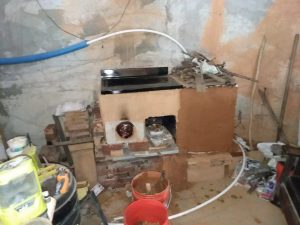
This extended bell houses a naked 20 gallon water tank with two fittings, one for cold water at the bottom and one for hot at the top.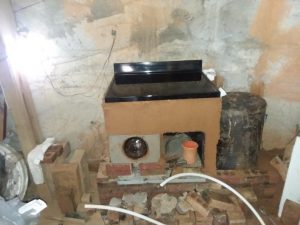
The top fitting connects directly into the hot water feed for my house system, and while in operation the hot water valve to the shower head in my tub is left open, and the cold water flow to the tank is shut off. This allows excess pressure to escape safely, and notifies me when the water is hot as steam starts to escape. Note that this is primarily proof of concept, and not yet ready for prime time water heating, it could easily have safety features added that would further ensure a more automatic type system.
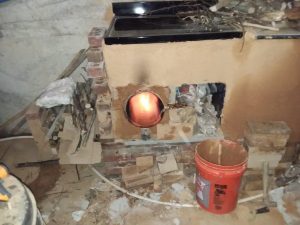 note the new visions fry pan “door” to the batch box, The lid I was using had broken into two pieces possibly from rough handling, possibly the lids are not as thermally robust as the pans
note the new visions fry pan “door” to the batch box, The lid I was using had broken into two pieces possibly from rough handling, possibly the lids are not as thermally robust as the pans
Last night I was burning the third batch of wood in the firebox,low grade poplar and some mystery wood, likely not completely dry, when I started to hear the steam. That produced a luxurious long (10 min at 4-5 gal/min), very hot shower (mixing lots of cold water). I was concerned about stratification, and the possibility that all the water would not heat evenly, but the length and relatively constant heat of the shower indicated this was not an issue.
The design inside takes the combustion gases exiting under the stove top into a very broad vertical opening that directs the hot gases forward into a circular motion around the whole vertical surface of the tank, with some small horizontal space over and under the tank.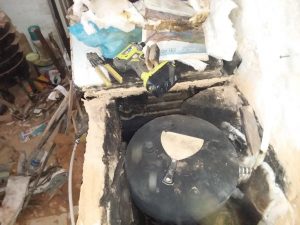 These gasses that are further cooled start to sink to the bottom as they circulate. The “stack” entrance is below the bottom of the tank in back of the system, so the exhaust comes in contact with about 270 degrees of the surface of the tank, with some minor contact top and bottom. Note that this stack is actually a powered exhaust by a very cheap, low wattage (about 10)fan. This provides a more or less guaranteed exhaust even at startup, and the exhaust is so cool (around 100F) that more robust (and expensive) equipment is not needed.
These gasses that are further cooled start to sink to the bottom as they circulate. The “stack” entrance is below the bottom of the tank in back of the system, so the exhaust comes in contact with about 270 degrees of the surface of the tank, with some minor contact top and bottom. Note that this stack is actually a powered exhaust by a very cheap, low wattage (about 10)fan. This provides a more or less guaranteed exhaust even at startup, and the exhaust is so cool (around 100F) that more robust (and expensive) equipment is not needed.
The test run last night reached temperatures on top of the port between 900 and 1000 F during the third batch of wood, with a very robust secondary burn at the port. Without testing equipment I have no way of knowing just how clean this is burning, but it appears that the system gets more efficient into the second and third batch of wood by the size of the secondary burn. 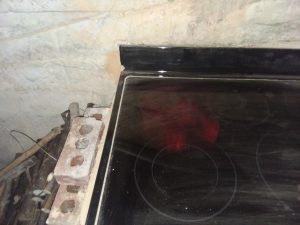 Perhaps using insulated Fire brick at the port would get the port to temperature more quickly (it is currently standard , full fire brick), and adding ceramic fiber blanket over the stove top might also enhance the temperature build up by reducing convection and radiation losses there.
Perhaps using insulated Fire brick at the port would get the port to temperature more quickly (it is currently standard , full fire brick), and adding ceramic fiber blanket over the stove top might also enhance the temperature build up by reducing convection and radiation losses there.
Thanks for posting. I had thought I would build a DSR until I saw comments that it is recommended. Now I’m stuck wondering what to do. I’m glad to see it seems to be working for you.